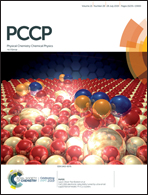Recyclable and superior selective CO2 adsorption of C4B32 and Ca@C4B32: a new category of perfect cubic heteroborospherenes†
Abstract
The capture and separation of CO2 have attracted significant interest as a strategy to control the global emission of greenhouse gases. From the perspective of environmental protection, it is crucial to explore high-performance adsorbents that can efficiently capture CO2. Herein, we report a density functional theory study on the viability of the heteroborospherene C4B32 for the first time. C2v C4B32 was revealed to be a perfect cubic heteroborospherene with the HOMO–LUMO gap of 3.47 eV at the PBE0 level. Then, we evaluated the potential application of C4B32 in the capture and separation of CO2. Our results indicate that the cubic-like C4B32 can efficiently capture CO2 with a −1.34 eV adsorption energy via chemisorption at the most acidic and basic sites of the cage. The strong interaction between CO2 and C4B32 could be supported by an effective charge transfer and orbital overlap. C4B32 also displayed high selectivity for the separation of CO2 from NH3, N2, CH4, CO, and H2 mixtures. Furthermore, it was feasible to tune the CO2-capture ability of C4B32 by metal-doping, which regulated the Lewis acidity/basicity of the C4B32 surface. In particular, Ca-doping could significantly enhance the CO2-capture ability of C4B32. Our results show that as a highly symmetrical and stable heteroborospherene, C4B32 can be used as a building block for the design and synthesis of novel nanomaterials for the capture and separation of CO2.



 Please wait while we load your content...
Please wait while we load your content...